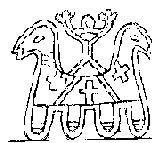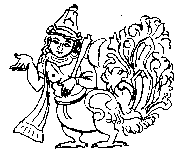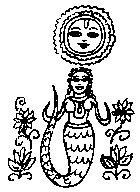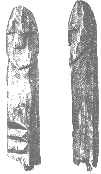

These days Russia goes through not only the economic crisis, but also succumbs to the identity crisis. While many hail to the idea of Orthodox Christian Russia, others are not happy with the cultural consequences it brings and therefore delve into the pre-Christian past, trying to find there roots of Russian identity. Some of these scholars are researching the possibility of the Aryan ancestry of the Slavs. They insist on the cultural and linguistic unity of both families. Academic Rybakov B.A. is of the opinion due to the facts, concerning Tripolskaya culture, which was situated near the Northern Black Sea coast. While close connection of Slavs with Tripol culture is generally not disputed, Rybakov makes a point, that Tripol murals are the illustrative material to the 10 hymn of Rg Veda (Gornung B.V. From prehistory…P.218) He also sees Slavic-Aryan common roots in the names of the pagan gods (compare: Svarog - name of the god of heaven and Skt. svarga, sky; then Slavic Indrik, Indrok and Skt. indra; Slavic god of the wind Stribog and Skt. verb strI) and also the symbols of the two communities:
 |
 |
On the left you may see Slavic god of Sun (Dajbog ?) and on the right Indian folk picture of the Sun god. Two-headed horse represents the Sun. There are more symbols, both characteristic to both communities, that Rybakov brings:
|
Half-maiden half-bird. Left: Slavs, right: India |
 |
|
Water maiden. Left: Slavs, right: India. |
 |
Another feature, which Rybakov mentions is the likeliness of the phallic cult and the cult of the fertility goddess. It’s known, that almost all archaic tribes had these cults, yet in Slavic Rus it had some very interesting features. In the chronic it’s mentioned, that Slavs used to worship “sramniye udy”, phallus, which received offerings during the wedding ceremony (see on the right phallus from Staraya Russa, XI c.)
|
Worship of the fertility Gods and goddesses was also very prominent in Rus. Main fertility god was Rod (compare Rudra). Rybakov mentions one of the ziva’s name is ziznadeva, zizna corresponds to male organ and in Russian one of the meanings of the word shish is the same. In the fertility rituals, rhombic patterns, beautifying images of the goddesses are also wide spread both in Rus and AryAvarta. |
 |
There are some other similar rituals, like enthroning of the silver head with the golden moustache (ritual, that Slavs used to do for their god Perun; author says it’s practiced in Maharastra on the shrines of the saints).
Cosmological views are often also similar. Thus, it’s known that Indo-Iranians believed in the beginning of the universe from the cosmic egg. In the Slavic Russia egg still symbolizes the beginning of life (on the Easter, for example). Polar star is identified with the pivot of the universe in the Indo-Iranian community, as for the Slavs, it used to be called Stojar, which also means “a poll in the middle of the stack – stog – of hay”.
Scholar N.Guseva conducted a linguistic research of the neighborhood (or kinship?) of Aryans and Slavs. Common words, ritualistic terminology and names of gods often have clear Sanskrit derivatives. She offers about a hundred words in evidence. Here are some of the examples that she brings out:
|
Russian |
meaning |
Sanskrit |
|
|
Kogda |
When |
kadA |
|
|
Oba |
Both |
ubhA |
|
|
Tot |
That |
tat |
|
|
Vsegda |
Always |
sadA |
|
|
Togda |
Then |
tadA |
|
|
Putnik |
Traveler |
pathika |
|
|
Estestvo |
Being |
astitva |
|
|
Dom |
House |
dham |
|
|
Jena |
Wife |
jani |
|
|
Mat’ |
Mother |
mAtR |
|
|
Syn |
Son |
sUnu, sUna |
|
|
Snoha |
Daughter-in-law |
snuSa |
|
|
Svoystvo |
Property |
svatva |
|
|
Dever |
Brother-in-law |
devar |
|
|
Zyat |
Son-in-law |
jata, jati |
|
|
Brat |
Brother |
bhrAtaH |
|
|
Tata, tyatya – father (voc.) |
tAta – my darling, my brother, my uncle (voc.) |
||
Toponymy is especially ancient lexicological layer; names of the rivers, lakes, hills often can say more, then archeological findings. That is probably why, search of the universal roots of the world civilizations make many scholars turn to the toponymy. N.O.Trubachev brings a list of 150 toponyms of the Crimea proving their Indo-Iranian origin:

S.Jarnikova cites in her works 80 hydronyms of the Russian Murmansk, Arhangelsk and Vologda regions with their Sanskrit roots. If the phenomena was wide spread, it must have the occurrence in other regions, we thought. With this supposition in our minds we decided to analyze hydronyms of the Vladimir region, which is situated to a North-East from Moscow. Founded in the Xth century, it used to be a Northern Russian capital up to XIVth century. First we made a list of all hydronyms and sorted them according their visually Slavic or Ugro-Finnish origin. About 30 % of the hydronyms of Vladimir region are Slavic. These are rivers and lakes like Uvod’, Suvod’, Gus’, Karaslitsa, Ponyhar, Kolp’ and dozens of others. You can often find their derivation by using Dal’s and Fasmer’s dictionaries.
About 60 % of the hydronyms happened to be Ugro-Finnish, which is no surprise, since Vladimir region used to be an areal for these tribes. They are, for example: Vyazma, Nerehta, Podoksa, Sudogda, Klyazma and others. Most of the Sanskrit related hydronyms are likely to be in the Ugro-Finnish group. Below is the list of the rivers and lakes in capital letters and their possible derivation.
ANJA
aJj to purify
aJjas swift
ARGA
arc to glow, emanate
argha price, gift
arS to flow
arNava flow
arNas river
INDRUS
indriya strength, might
(There is a river Indraja in Lithuania)
URDA
urda sportful , cheerful
Urdhvas high
USHNA
uSNa
Meaning
mf(%{A} , rarely %{I})n. (Un2. iii , 2) hot , warm ; ardent , passionate , impetuous RV. x , 4 , 2 AV. vi , 68 , 1 ; viii , 9 , 17 S3Br. ChUp. Sus3r. Mn. &c. ; pungent , acrid ; sharp , active L. ; m. onion L. [220,2] ; N. of a man VP. ; (%{as} , %{am}) m. n. heat , warmth , the hot season (June , July) Mn. xi , 113 S3ak. Das3. &c. ; any hot object MBh.
KSHARA
kSara melting, disappearing; water
kSAra caustic , biting , corrosive , acrid , pungent
SENTUR
setu bridge, dam
SURA
sura god, divinity, deity
surA to distil, spirituous liquor , wine (in ancient times `" a kind of beer "') ; spirituous liquor (personified as a daughter of Varun2a produced at the churning of the ocean) RV. &c. &c. ; water Naigh. i , 12 ; a drinking vessel L.
sUra m. (fr. 3. %{su}) the Soma-juice flowing from the Soma press RV. AV.
GARAVA
gar to splash
ghar to water
ghar-ghara thundering, gurgling
gara drink
garala poison
NARMA
narma amusement, play
MOKSHUR
mokSa liberation
mekSanam to mix
DANDUR
dAnu to flow; flowing liquid
TARA
tara river crossing
taraGga wave
taraGgiNI river
tari boat
taraNi flowing, fast
TRAMA
traANa, trAman protection, guard
TOYMIGA
toya water
There are many complex words in Sanskrit, beginning with “water”
toya-ja born in water
toyadhara containing water
toyamaya consisting of water
mIna fish
VISHA
viSa poison
Although some other names stirred our attention – Siverka (Skt. ziv), Snoved’ (Skt. ved), Ramenka (Skt. rAma), Kura (Skt.kuru), Charmus (Skt. cAru), Yada (Skt. yada), Luh (Skt. luh-lubh-lohati), Lamna (Skt. lamna, loman), Nasmur (Skt. nAsA) since their possible Sanskrit derivation didn’t happen to be concerned with water we disregarded them as “faux amis”.
You may notice, that most of hydronyms, that are likely to have some connection with Sanskrit are Ugro-Finnish by the ending, so it may be also so, that these names were brought by the Ugro-Finnish groups, that were once prominent in the Russian territory. We may conclude then, that Sanskrit rooted hydronyms indicate of the early Ugro-Finnish contacts with Indo-Iranians rather then the contacts of the Slavs with them.
Bibliography.